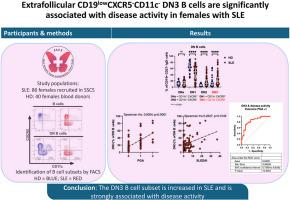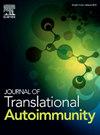卵泡外 CD19lowCXCR5-CD11c- 双阴性 3 (DN3) B 细胞与系统性红斑狼疮女性患者的疾病活动显著相关
IF 3.6
Q2 IMMUNOLOGY
引用次数: 0
摘要
目的B细胞在系统性红斑狼疮(SLE)的发生和维持中起着重要作用。双阴性(DN)B细胞的定义是缺乏 IgD 和 CD27 的表面表达,它们对 Toll 样受体 7(TLR7)配体的敏感性及其在自身抗体产生中的潜在作用最近引起了人们的兴趣。在此,我们旨在研究 DN B 细胞及其亚群与系统性红斑狼疮疾病活动的可能关联,特别是在女性患者中,有报道称 TLR7 基因可逃避 X 染色体失活。方法:从参与临床特征良好的瑞士系统性红斑狼疮队列研究(SSCS)的女性患者中纯化外周血单核细胞。以年龄匹配的健康女性的外周血单核细胞为对照。对 PBMC 进行细胞表面标记物和细胞内 Tbet 染色,并用多色细胞荧光测定法进行分析。结果86名女性的系统性红斑狼疮疾病活动指数中位数为2,IQR[0-6],除8名女性外,其余女性均接受过慢性系统性红斑狼疮治疗。与 40 名健康供体(HD)相比,我们观察到系统性红斑狼疮患者 CD11c + CXCR5 和 CD11c-CXCR5 大量增加,同时 CD11c-CXCR5+ B 细胞减少。当关注 DN B 细胞亚群时,我们发现 DN1(CD11c-CXCR5+)细胞减少,DN2(CD11c + CXCR5-)细胞增加,最令人印象深刻的是 DN3(CD11c-CXCR5-)细胞。DN 亚群,尤其是 DN3,CD19 表达水平最低。DN1和DN3的百分比以及DN细胞的CD19 MFI都与系统性红斑狼疮的疾病活动有关。使用糖皮质激素、免疫抑制剂和抗疟药会对 DN B 细胞亚群的频率产生不同程度的影响。B 细胞中 CD19 MFI 和 DN3 的百分比是疾病活动性最强的生物标志物。TLR7 snp3858384 G等位基因与B细胞和CD19+CD11c-CXCR5+百分比升高和CD19+CD11c-CXCR5-百分比降低有关。本文章由计算机程序翻译,如有差异,请以英文原文为准。

Extrafollicular CD19lowCXCR5−CD11c− double negative 3 (DN3) B cells are significantly associated with disease activity in females with systemic lupus erythematosus
Objective
B cells play a major role in the development and maintenance of systemic lupus erythematosus (SLE). Double negative (DN) B cells defined by the lack of surface expression of IgD and CD27 have attracted recent interest for their sensitivity to Toll-like receptor 7 (TLR7) ligands and their potential role in the production of autoantibodies. Here we aimed at investigating the possible association of DN B cells and their subsets with SLE disease activity specifically in female patients, in which TLR7 gene has been reported to escape X chromosome inactivation.
Methods
Peripheral blood mononuclear cells were purified from woman participating to the clinically well-characterized Swiss SLE Cohort Study (SSCS). PBMC from age-matched healthy females were used as controls. PBMC were stained for cell surface markers, intracellular Tbet and analyzed by multicolor cytofluorimetry. Single nucleotide TLR7 polymorphisms were assessed by polymerase chain reaction.
Results
The median SLE disease activity index of the 86 females was 2, IQR [0–6], all but 8 were under chronic SLE treatment. B cells co-expressing CD11c and Tbet were increased, the mean fluorescence intensity (MFI) of CD19 was considerably reduced and we observed a large increase in CD11c + CXCR5-and CD11c-CXCR5-concomitantly with a reduction of CD11c-CXCR5+ B cells in SLE compared to 40 healthy donors (HD). When focusing on the DN B cell subset, we found a reduction of DN1 (CD11c-CXCR5+) and an increase of DN2 (CD11c + CXCR5-) and most impressively of DN3 (CD11c-CXCR5-) cells. The DN subset, particularly DN3, showed the lowest level of CD19 expression. Both DN1 and DN3 percentages as well as the CD19 MFI of DN cells were associated with SLE disease activity. The use of glucocorticoids, immunosuppressants, and antimalarials impacted differentially on the frequencies of DN B cell subsets. CD19 MFI in B cells and the percentage of DN3 were the strongest biomarkers of disease activity. The TLR7 snp3858384 G allele was associated with increased percentages of B cells and CD19+CD11c-CXCR5+ and decreased CD19+CD11c-CXCR5-.
Conclusions
DN3 B cells are strongly associated with SLE clinical activity pointing to their potential involvement in disease pathogenesis, and CD19 expression level performs accurately as disease activity biomarker.
求助全文
通过发布文献求助,成功后即可免费获取论文全文。
去求助
来源期刊

Journal of Translational Autoimmunity
Medicine-Immunology and Allergy
CiteScore
7.80
自引率
2.60%
发文量
33
审稿时长
55 days
 求助内容:
求助内容: 应助结果提醒方式:
应助结果提醒方式:


